Critical Evaluation of a Development Project on Teenage Alcohol Abuse
VerifiedAdded on 2022/11/19
|8
|1562
|464
Report
AI Summary
This report provides a critical evaluation of a development project designed to address the growing issue of teenage alcohol abuse. The project focuses on strategies implemented by various stakeholders, including local governments, police, healthcare providers, and the community, to reduce alcohol consumption among adolescents. The analysis examines the project's effectiveness by evaluating specific strategies such as implementing alcohol policies, reviewing liquor licenses, promoting safer communities, and conducting regular inspections. The report also highlights additional factors contributing to alcohol abuse, such as social exclusion and conflict management, which were not addressed in the original project. It emphasizes the importance of primary and secondary research in understanding the severity of the issue and suggests the inclusion of community development concepts to enhance the project's impact. The conclusion reiterates the need for a multi-faceted approach to tackle teenage alcohol abuse, incorporating various strategies to reduce consumption and mitigate associated harms.
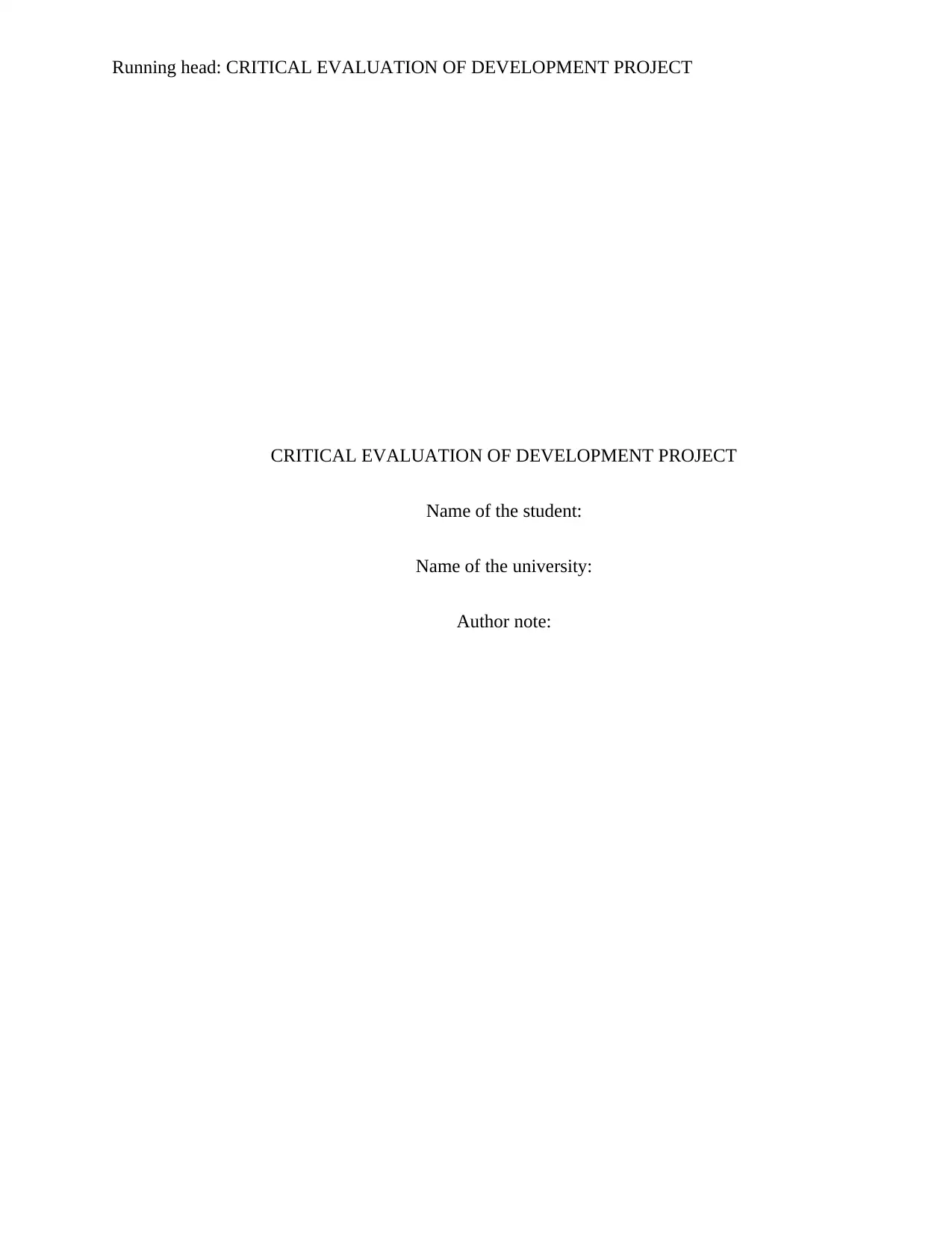
Running head: CRITICAL EVALUATION OF DEVELOPMENT PROJECT
CRITICAL EVALUATION OF DEVELOPMENT PROJECT
Name of the student:
Name of the university:
Author note:
CRITICAL EVALUATION OF DEVELOPMENT PROJECT
Name of the student:
Name of the university:
Author note:
Paraphrase This Document
Need a fresh take? Get an instant paraphrase of this document with our AI Paraphraser
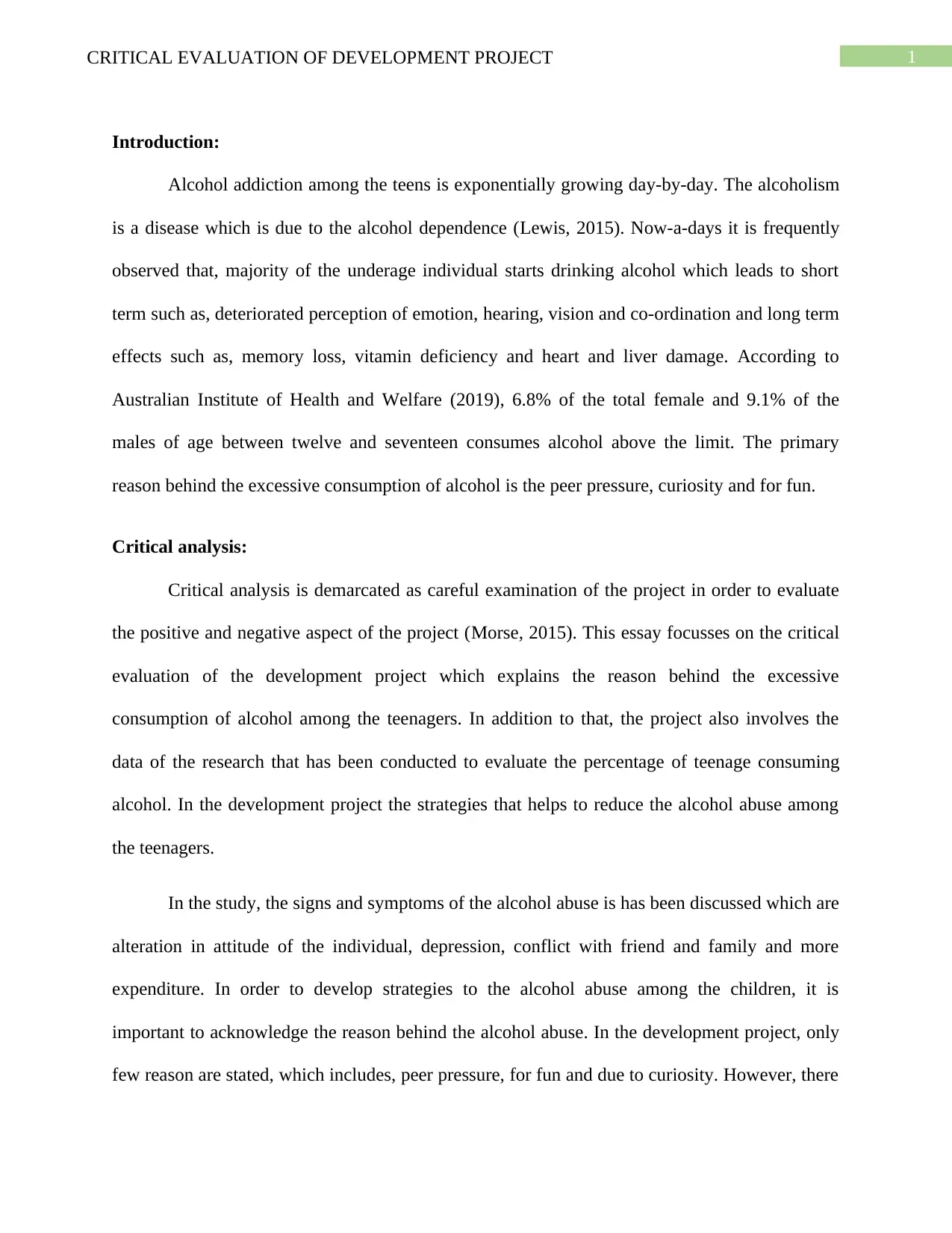
1CRITICAL EVALUATION OF DEVELOPMENT PROJECT
Introduction:
Alcohol addiction among the teens is exponentially growing day-by-day. The alcoholism
is a disease which is due to the alcohol dependence (Lewis, 2015). Now-a-days it is frequently
observed that, majority of the underage individual starts drinking alcohol which leads to short
term such as, deteriorated perception of emotion, hearing, vision and co-ordination and long term
effects such as, memory loss, vitamin deficiency and heart and liver damage. According to
Australian Institute of Health and Welfare (2019), 6.8% of the total female and 9.1% of the
males of age between twelve and seventeen consumes alcohol above the limit. The primary
reason behind the excessive consumption of alcohol is the peer pressure, curiosity and for fun.
Critical analysis:
Critical analysis is demarcated as careful examination of the project in order to evaluate
the positive and negative aspect of the project (Morse, 2015). This essay focusses on the critical
evaluation of the development project which explains the reason behind the excessive
consumption of alcohol among the teenagers. In addition to that, the project also involves the
data of the research that has been conducted to evaluate the percentage of teenage consuming
alcohol. In the development project the strategies that helps to reduce the alcohol abuse among
the teenagers.
In the study, the signs and symptoms of the alcohol abuse is has been discussed which are
alteration in attitude of the individual, depression, conflict with friend and family and more
expenditure. In order to develop strategies to the alcohol abuse among the children, it is
important to acknowledge the reason behind the alcohol abuse. In the development project, only
few reason are stated, which includes, peer pressure, for fun and due to curiosity. However, there
Introduction:
Alcohol addiction among the teens is exponentially growing day-by-day. The alcoholism
is a disease which is due to the alcohol dependence (Lewis, 2015). Now-a-days it is frequently
observed that, majority of the underage individual starts drinking alcohol which leads to short
term such as, deteriorated perception of emotion, hearing, vision and co-ordination and long term
effects such as, memory loss, vitamin deficiency and heart and liver damage. According to
Australian Institute of Health and Welfare (2019), 6.8% of the total female and 9.1% of the
males of age between twelve and seventeen consumes alcohol above the limit. The primary
reason behind the excessive consumption of alcohol is the peer pressure, curiosity and for fun.
Critical analysis:
Critical analysis is demarcated as careful examination of the project in order to evaluate
the positive and negative aspect of the project (Morse, 2015). This essay focusses on the critical
evaluation of the development project which explains the reason behind the excessive
consumption of alcohol among the teenagers. In addition to that, the project also involves the
data of the research that has been conducted to evaluate the percentage of teenage consuming
alcohol. In the development project the strategies that helps to reduce the alcohol abuse among
the teenagers.
In the study, the signs and symptoms of the alcohol abuse is has been discussed which are
alteration in attitude of the individual, depression, conflict with friend and family and more
expenditure. In order to develop strategies to the alcohol abuse among the children, it is
important to acknowledge the reason behind the alcohol abuse. In the development project, only
few reason are stated, which includes, peer pressure, for fun and due to curiosity. However, there
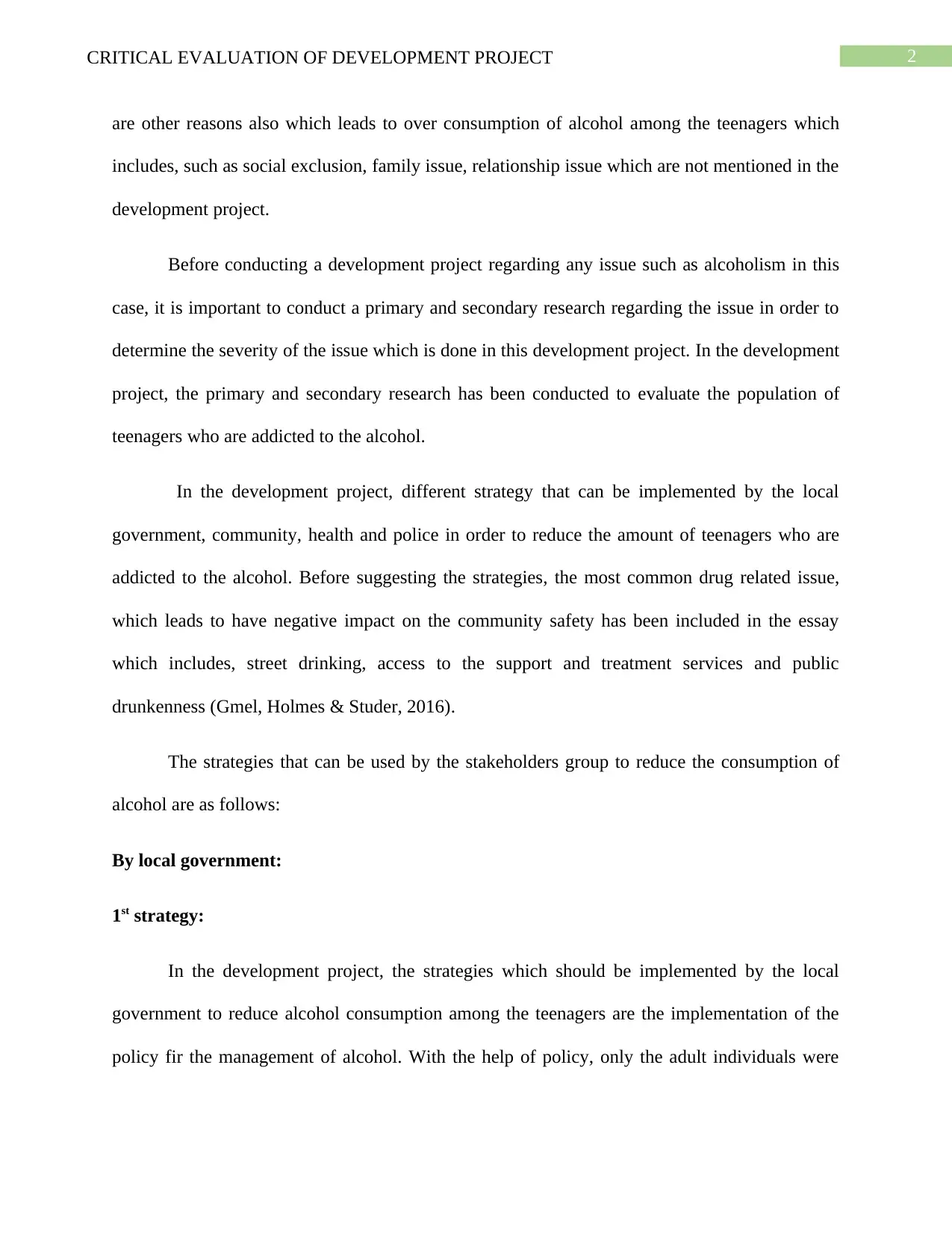
2CRITICAL EVALUATION OF DEVELOPMENT PROJECT
are other reasons also which leads to over consumption of alcohol among the teenagers which
includes, such as social exclusion, family issue, relationship issue which are not mentioned in the
development project.
Before conducting a development project regarding any issue such as alcoholism in this
case, it is important to conduct a primary and secondary research regarding the issue in order to
determine the severity of the issue which is done in this development project. In the development
project, the primary and secondary research has been conducted to evaluate the population of
teenagers who are addicted to the alcohol.
In the development project, different strategy that can be implemented by the local
government, community, health and police in order to reduce the amount of teenagers who are
addicted to the alcohol. Before suggesting the strategies, the most common drug related issue,
which leads to have negative impact on the community safety has been included in the essay
which includes, street drinking, access to the support and treatment services and public
drunkenness (Gmel, Holmes & Studer, 2016).
The strategies that can be used by the stakeholders group to reduce the consumption of
alcohol are as follows:
By local government:
1st strategy:
In the development project, the strategies which should be implemented by the local
government to reduce alcohol consumption among the teenagers are the implementation of the
policy fir the management of alcohol. With the help of policy, only the adult individuals were
are other reasons also which leads to over consumption of alcohol among the teenagers which
includes, such as social exclusion, family issue, relationship issue which are not mentioned in the
development project.
Before conducting a development project regarding any issue such as alcoholism in this
case, it is important to conduct a primary and secondary research regarding the issue in order to
determine the severity of the issue which is done in this development project. In the development
project, the primary and secondary research has been conducted to evaluate the population of
teenagers who are addicted to the alcohol.
In the development project, different strategy that can be implemented by the local
government, community, health and police in order to reduce the amount of teenagers who are
addicted to the alcohol. Before suggesting the strategies, the most common drug related issue,
which leads to have negative impact on the community safety has been included in the essay
which includes, street drinking, access to the support and treatment services and public
drunkenness (Gmel, Holmes & Studer, 2016).
The strategies that can be used by the stakeholders group to reduce the consumption of
alcohol are as follows:
By local government:
1st strategy:
In the development project, the strategies which should be implemented by the local
government to reduce alcohol consumption among the teenagers are the implementation of the
policy fir the management of alcohol. With the help of policy, only the adult individuals were
⊘ This is a preview!⊘
Do you want full access?
Subscribe today to unlock all pages.

Trusted by 1+ million students worldwide
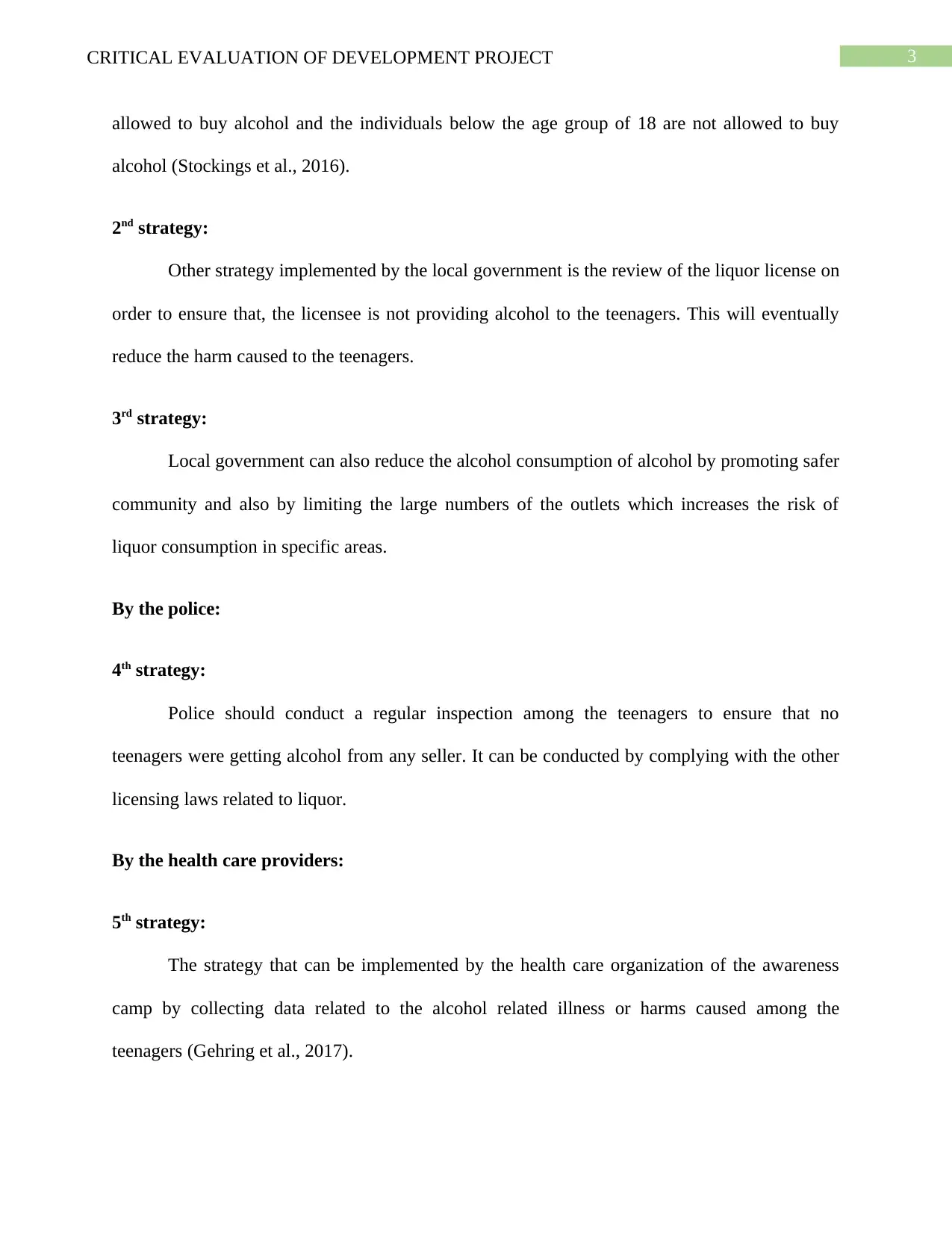
3CRITICAL EVALUATION OF DEVELOPMENT PROJECT
allowed to buy alcohol and the individuals below the age group of 18 are not allowed to buy
alcohol (Stockings et al., 2016).
2nd strategy:
Other strategy implemented by the local government is the review of the liquor license on
order to ensure that, the licensee is not providing alcohol to the teenagers. This will eventually
reduce the harm caused to the teenagers.
3rd strategy:
Local government can also reduce the alcohol consumption of alcohol by promoting safer
community and also by limiting the large numbers of the outlets which increases the risk of
liquor consumption in specific areas.
By the police:
4th strategy:
Police should conduct a regular inspection among the teenagers to ensure that no
teenagers were getting alcohol from any seller. It can be conducted by complying with the other
licensing laws related to liquor.
By the health care providers:
5th strategy:
The strategy that can be implemented by the health care organization of the awareness
camp by collecting data related to the alcohol related illness or harms caused among the
teenagers (Gehring et al., 2017).
allowed to buy alcohol and the individuals below the age group of 18 are not allowed to buy
alcohol (Stockings et al., 2016).
2nd strategy:
Other strategy implemented by the local government is the review of the liquor license on
order to ensure that, the licensee is not providing alcohol to the teenagers. This will eventually
reduce the harm caused to the teenagers.
3rd strategy:
Local government can also reduce the alcohol consumption of alcohol by promoting safer
community and also by limiting the large numbers of the outlets which increases the risk of
liquor consumption in specific areas.
By the police:
4th strategy:
Police should conduct a regular inspection among the teenagers to ensure that no
teenagers were getting alcohol from any seller. It can be conducted by complying with the other
licensing laws related to liquor.
By the health care providers:
5th strategy:
The strategy that can be implemented by the health care organization of the awareness
camp by collecting data related to the alcohol related illness or harms caused among the
teenagers (Gehring et al., 2017).
Paraphrase This Document
Need a fresh take? Get an instant paraphrase of this document with our AI Paraphraser
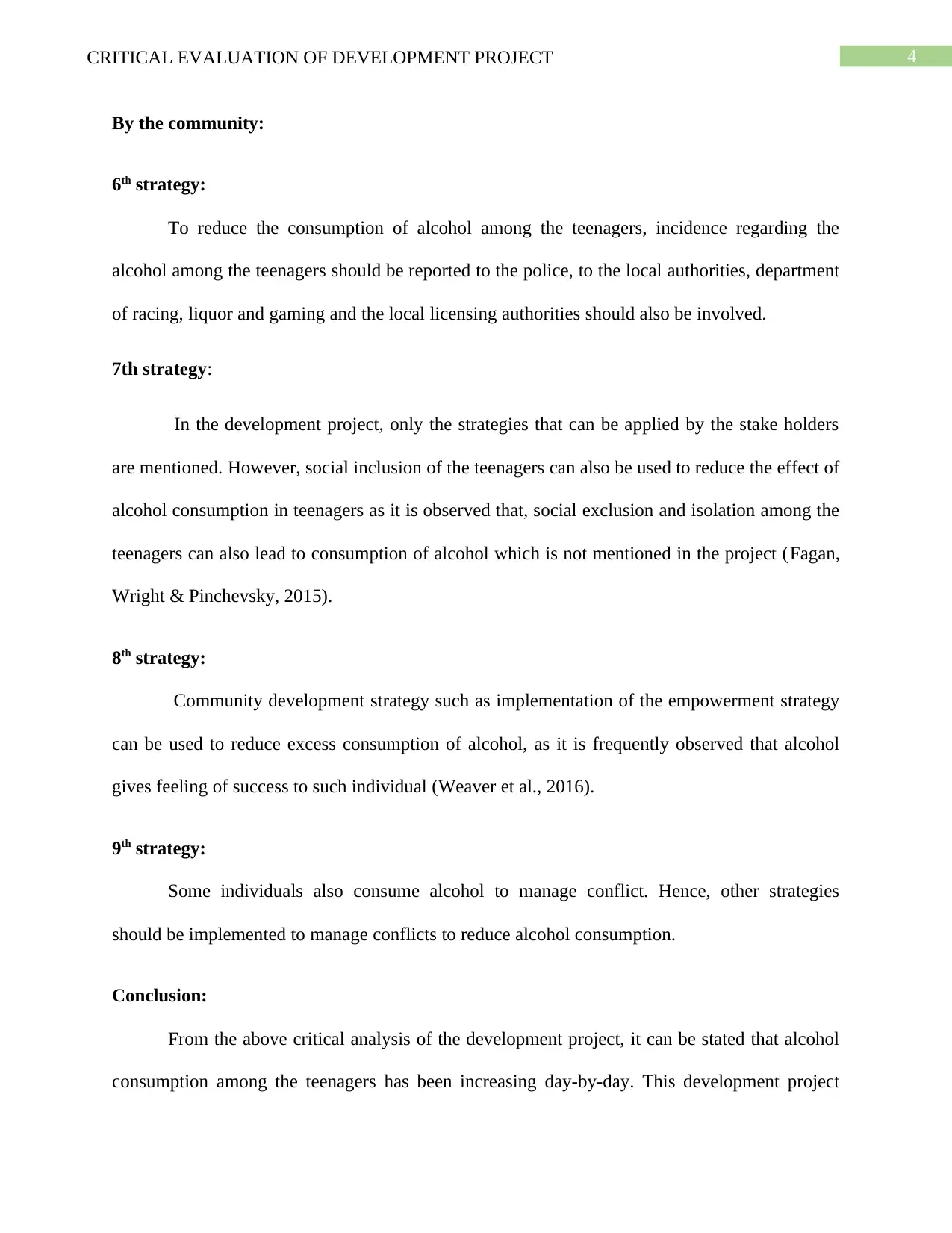
4CRITICAL EVALUATION OF DEVELOPMENT PROJECT
By the community:
6th strategy:
To reduce the consumption of alcohol among the teenagers, incidence regarding the
alcohol among the teenagers should be reported to the police, to the local authorities, department
of racing, liquor and gaming and the local licensing authorities should also be involved.
7th strategy:
In the development project, only the strategies that can be applied by the stake holders
are mentioned. However, social inclusion of the teenagers can also be used to reduce the effect of
alcohol consumption in teenagers as it is observed that, social exclusion and isolation among the
teenagers can also lead to consumption of alcohol which is not mentioned in the project (Fagan,
Wright & Pinchevsky, 2015).
8th strategy:
Community development strategy such as implementation of the empowerment strategy
can be used to reduce excess consumption of alcohol, as it is frequently observed that alcohol
gives feeling of success to such individual (Weaver et al., 2016).
9th strategy:
Some individuals also consume alcohol to manage conflict. Hence, other strategies
should be implemented to manage conflicts to reduce alcohol consumption.
Conclusion:
From the above critical analysis of the development project, it can be stated that alcohol
consumption among the teenagers has been increasing day-by-day. This development project
By the community:
6th strategy:
To reduce the consumption of alcohol among the teenagers, incidence regarding the
alcohol among the teenagers should be reported to the police, to the local authorities, department
of racing, liquor and gaming and the local licensing authorities should also be involved.
7th strategy:
In the development project, only the strategies that can be applied by the stake holders
are mentioned. However, social inclusion of the teenagers can also be used to reduce the effect of
alcohol consumption in teenagers as it is observed that, social exclusion and isolation among the
teenagers can also lead to consumption of alcohol which is not mentioned in the project (Fagan,
Wright & Pinchevsky, 2015).
8th strategy:
Community development strategy such as implementation of the empowerment strategy
can be used to reduce excess consumption of alcohol, as it is frequently observed that alcohol
gives feeling of success to such individual (Weaver et al., 2016).
9th strategy:
Some individuals also consume alcohol to manage conflict. Hence, other strategies
should be implemented to manage conflicts to reduce alcohol consumption.
Conclusion:
From the above critical analysis of the development project, it can be stated that alcohol
consumption among the teenagers has been increasing day-by-day. This development project
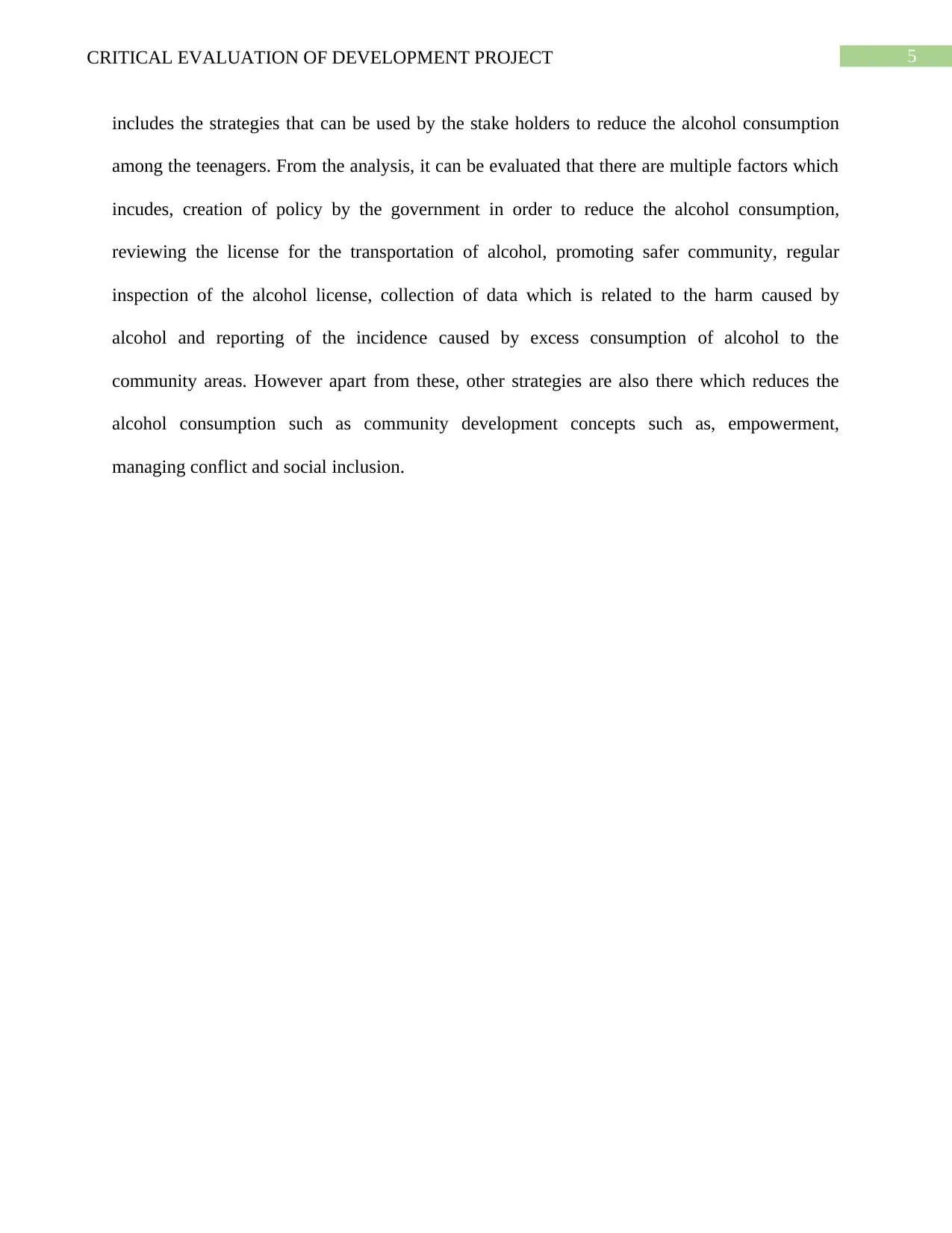
5CRITICAL EVALUATION OF DEVELOPMENT PROJECT
includes the strategies that can be used by the stake holders to reduce the alcohol consumption
among the teenagers. From the analysis, it can be evaluated that there are multiple factors which
incudes, creation of policy by the government in order to reduce the alcohol consumption,
reviewing the license for the transportation of alcohol, promoting safer community, regular
inspection of the alcohol license, collection of data which is related to the harm caused by
alcohol and reporting of the incidence caused by excess consumption of alcohol to the
community areas. However apart from these, other strategies are also there which reduces the
alcohol consumption such as community development concepts such as, empowerment,
managing conflict and social inclusion.
includes the strategies that can be used by the stake holders to reduce the alcohol consumption
among the teenagers. From the analysis, it can be evaluated that there are multiple factors which
incudes, creation of policy by the government in order to reduce the alcohol consumption,
reviewing the license for the transportation of alcohol, promoting safer community, regular
inspection of the alcohol license, collection of data which is related to the harm caused by
alcohol and reporting of the incidence caused by excess consumption of alcohol to the
community areas. However apart from these, other strategies are also there which reduces the
alcohol consumption such as community development concepts such as, empowerment,
managing conflict and social inclusion.
⊘ This is a preview!⊘
Do you want full access?
Subscribe today to unlock all pages.

Trusted by 1+ million students worldwide
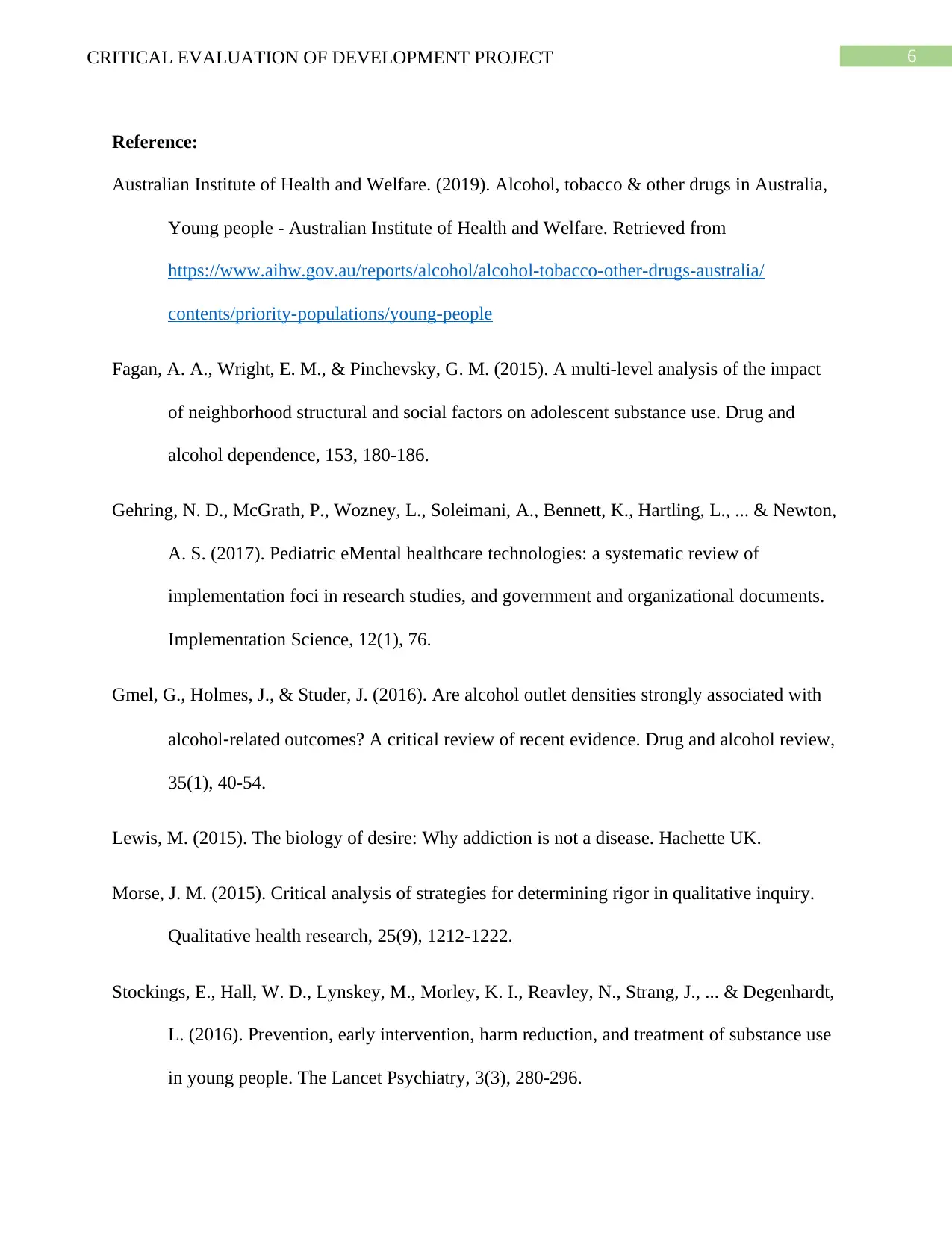
6CRITICAL EVALUATION OF DEVELOPMENT PROJECT
Reference:
Australian Institute of Health and Welfare. (2019). Alcohol, tobacco & other drugs in Australia,
Young people - Australian Institute of Health and Welfare. Retrieved from
https://www.aihw.gov.au/reports/alcohol/alcohol-tobacco-other-drugs-australia/
contents/priority-populations/young-people
Fagan, A. A., Wright, E. M., & Pinchevsky, G. M. (2015). A multi-level analysis of the impact
of neighborhood structural and social factors on adolescent substance use. Drug and
alcohol dependence, 153, 180-186.
Gehring, N. D., McGrath, P., Wozney, L., Soleimani, A., Bennett, K., Hartling, L., ... & Newton,
A. S. (2017). Pediatric eMental healthcare technologies: a systematic review of
implementation foci in research studies, and government and organizational documents.
Implementation Science, 12(1), 76.
Gmel, G., Holmes, J., & Studer, J. (2016). Are alcohol outlet densities strongly associated with
alcohol‐related outcomes? A critical review of recent evidence. Drug and alcohol review,
35(1), 40-54.
Lewis, M. (2015). The biology of desire: Why addiction is not a disease. Hachette UK.
Morse, J. M. (2015). Critical analysis of strategies for determining rigor in qualitative inquiry.
Qualitative health research, 25(9), 1212-1222.
Stockings, E., Hall, W. D., Lynskey, M., Morley, K. I., Reavley, N., Strang, J., ... & Degenhardt,
L. (2016). Prevention, early intervention, harm reduction, and treatment of substance use
in young people. The Lancet Psychiatry, 3(3), 280-296.
Reference:
Australian Institute of Health and Welfare. (2019). Alcohol, tobacco & other drugs in Australia,
Young people - Australian Institute of Health and Welfare. Retrieved from
https://www.aihw.gov.au/reports/alcohol/alcohol-tobacco-other-drugs-australia/
contents/priority-populations/young-people
Fagan, A. A., Wright, E. M., & Pinchevsky, G. M. (2015). A multi-level analysis of the impact
of neighborhood structural and social factors on adolescent substance use. Drug and
alcohol dependence, 153, 180-186.
Gehring, N. D., McGrath, P., Wozney, L., Soleimani, A., Bennett, K., Hartling, L., ... & Newton,
A. S. (2017). Pediatric eMental healthcare technologies: a systematic review of
implementation foci in research studies, and government and organizational documents.
Implementation Science, 12(1), 76.
Gmel, G., Holmes, J., & Studer, J. (2016). Are alcohol outlet densities strongly associated with
alcohol‐related outcomes? A critical review of recent evidence. Drug and alcohol review,
35(1), 40-54.
Lewis, M. (2015). The biology of desire: Why addiction is not a disease. Hachette UK.
Morse, J. M. (2015). Critical analysis of strategies for determining rigor in qualitative inquiry.
Qualitative health research, 25(9), 1212-1222.
Stockings, E., Hall, W. D., Lynskey, M., Morley, K. I., Reavley, N., Strang, J., ... & Degenhardt,
L. (2016). Prevention, early intervention, harm reduction, and treatment of substance use
in young people. The Lancet Psychiatry, 3(3), 280-296.
Paraphrase This Document
Need a fresh take? Get an instant paraphrase of this document with our AI Paraphraser
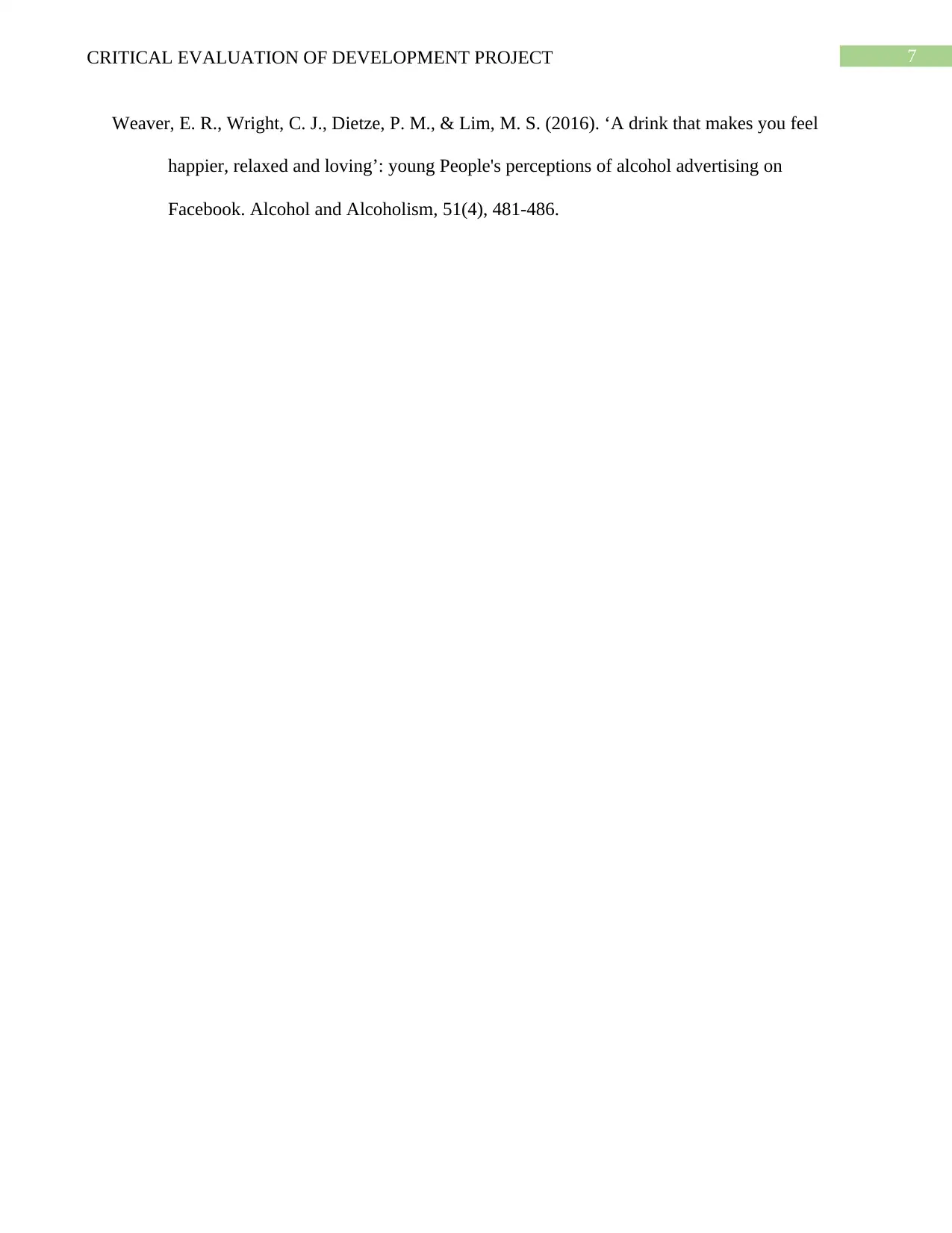
7CRITICAL EVALUATION OF DEVELOPMENT PROJECT
Weaver, E. R., Wright, C. J., Dietze, P. M., & Lim, M. S. (2016). ‘A drink that makes you feel
happier, relaxed and loving’: young People's perceptions of alcohol advertising on
Facebook. Alcohol and Alcoholism, 51(4), 481-486.
Weaver, E. R., Wright, C. J., Dietze, P. M., & Lim, M. S. (2016). ‘A drink that makes you feel
happier, relaxed and loving’: young People's perceptions of alcohol advertising on
Facebook. Alcohol and Alcoholism, 51(4), 481-486.
1 out of 8
Related Documents
Your All-in-One AI-Powered Toolkit for Academic Success.
+13062052269
info@desklib.com
Available 24*7 on WhatsApp / Email
![[object Object]](/_next/static/media/star-bottom.7253800d.svg)
Unlock your academic potential
Copyright © 2020–2025 A2Z Services. All Rights Reserved. Developed and managed by ZUCOL.




